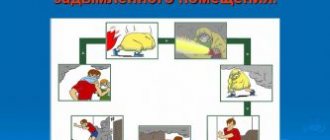Signs of a fire
According to statistics, the vast majority of dangerous fires occur due to human fault. Much less often the causes are natural: for example, a lightning strike. The sooner you notice that a fire has started, the sooner you will understand what to do to rescue and extinguish the flame. Main features:
- increasing burning smell;
- the appearance of acrid smoke that hurts the eyes;
- the smell of burning rubber;
- reflections of flames and the sound of crackling;
- The light bulbs in the room begin to burn poorly or go out completely.
A fire in any building (residential, public) and transport, as a rule, begins with the appearance of smoke, which at first is barely detectable, and then becomes caustic and hurts the eyes. It is accompanied by the smell of burnt rubber, which comes from burning electrical wiring. A little later, the lamps will become dimmer or the light will go out completely.
In open areas, smoke may not be noticeable (this depends on the wind direction and speed). There will be a noticeable smell of burning wood or grass.
The most characteristic signs of a fire are reflections of flames, crackling and loud whistling sounds: it seems as if wood is burning in a stove somewhere nearby.
How to behave in case of fire
The algorithm of actions is slightly different depending on what caught fire and where. The general rules of behavior are reflected in the following reminder in case of fire:
- You must call rescuers as quickly as possible. Sometimes people mistakenly believe that they can extinguish the fire on their own, and waste precious time. Provide the dispatcher with detailed information about the object and the incident. There is a safety rule according to which the person who called the rescuers must organize a meeting for them, clear the road, and provide quick access to the fire.
- Fire and panic are categorically incompatible concepts. By becoming hysterical, you put yourself in mortal danger. You should not do rash actions.
- Do not risk your life to save material assets: money, jewelry, art, etc.
- Help everyone get out of the room or away from the source of the fire.
- De-energize the object.
- When trying to put out a fire on your own, clearly distribute your forces and evaluate your capabilities. If it spreads excessively, you must have time to get to a safe place.
- Close windows and doors tightly if there is a fire in a confined space.
If you are helping to evacuate or want to put out a fire, follow these rules:
- Before entering a burning room full of smoke, wrap your head in a wet blanket or sheet.
- If you have to open windows and doors into rooms, do it as carefully as possible. An influx of fresh air is formed, causing a powerful fiery outbreak.
- When evacuating, move only along flights of stairs, do not try to take the elevator.
- To escape in case of fire and heavy smoke, you need to move closer to the ground.
- If your clothes start to burn, fall to the floor and roll vigorously, trying to knock out the flames. If you see this happen to one of the victims, immediately throw a coat, duvet cover, curtain or any large piece of fabric over the person and press very tightly.
In a private household
Actions in case of fire in a residential building:
- Call the fire department. Provide the dispatcher with as much detailed information as possible about the incident.
- Help everyone in the house get out.
- Try to turn off the electricity and turn off the gas.
- Cover your mouth and nose with a cloth soaked in cold water. Try to move closer to the floor: get on all fours or bend over.
- Do not open windows or doors unless you intend to evacuate the building.
- If the fire in the house is small, try to fight it with a fire extinguisher, ice water, durable material, or sand.
- If the fire spreads rapidly, leave the house.
- If you can’t get out, get to the window and attract the attention of passers-by.
- Meet the firefighters, show them the most convenient and shortest route to the site.
Fire in an apartment building
Tactics depend on the specific location of the fire. Actions in case of fire in the apartment:
- Urgently report the incident to the fire service by calling “01” or “112”.
- Make sure there is no risk of electric shock. If it persists, try turning off the power.
- You can try to extinguish a fire in an apartment with water after first de-energizing it. Also try to eliminate sources of ignition by covering them with a thick, damp cloth.
- Do not use water to extinguish flammable liquids or substances. They can be well sprinkled with earth or sand and covered with a thick wet cloth. It is best to use a special powder fire extinguisher.
- If you cannot eliminate the fire yourself, think over a plan for evacuating the apartment. Once you get out, immediately inform your neighbors and rescuers about the danger (if you haven’t already called them).
- In case of heavy smoke and very high temperatures, crawl towards the exit.
- If you cannot leave your home because of the fire, go out onto the balcony, closing the door tightly behind you. Shout loudly to get the attention of passersby.
- If you managed to get out of the apartment unhindered, wait for the firefighters and tell them in as much detail as possible about the location of the fire, the cause, and other details of the incident.
Actions in case of a fire in the basement of an apartment building:
- Call the rescuers.
- Notify your neighbors about the incident.
- If smoke begins to enter apartments, open them for ventilation.
- Do not try to get into the basement and put out the fire yourself.
- If you are in a room where a fire has occurred, quickly crawl to the exit.
What to do if there is a fire in the entrance:
- Call rescuers, inform your neighbors about the fire, and help them evacuate.
- If the smoke is small, try to find the source of the fire and localize it.
- If there is a lot of smoke on the sites, leave the entrance immediately. If you can’t go down the stairs, go out to the nearest balcony and wait for help.
In a public place
First you need to understand whether you will be able to leave the premises. To make sure there is no fire behind the door, place your hand on the canvas or iron handle. If you feel hot, open it. When moving through the rooms towards the exit, avoid those where there is a lot of smoke and the visibility limit is up to 10 meters.
What to do if a fire in a public place does not block the exits to the outside:
- Use main and emergency escape routes. There should be evacuation plans on the walls to guide your escape.
- It is better to move on all fours, because dangerous combustion products accumulate at approximately the height of an adult and above. Cover your mouth and nose with available means, such as wet clothing.
- If no one is following you, close the doors tightly behind you.
What to do if the neighboring rooms are too smoky and you can’t get out:
- Do not panic. Call the rescue service at “112” or “01” (“101).”
- Go to the room farthest from the fire.
- If possible, completely cover your body with a wet blanket. An alternative is to get all your clothes very wet. Be sure to cover your mouth and nose with a damp cloth.
- Check to see if you can climb down the fire escape or onto the roof.
- If evacuation from the premises is impossible, it must be reliably sealed to protect against smoke and fire. Close doors, vents, windows, and ventilation openings tightly. Plug all the cracks. If there is water in the room, periodically wet the doors and floor.
- Move around the room on all fours, especially if it is filled with smoke. Cover your nose and mouth with a damp cloth (sleeve, scarf). Get to the window and try to attract the attention of passers-by on the street.
Manager's reaction
Actions in case of fire at an enterprise: procedure, responsibilities of workers
The head of the institution or his replacement employee is obliged to follow the following procedure in the event of a fire in the premises:
- check whether the fire has already been reported to the fire department;
- lead the evacuation of people and extinguish the fire until fire departments arrive. If there is a threat to life, it is necessary to immediately organize the rescue of people, using all available forces and means;
- appoint a responsible person to meet fire departments who knows the location of access roads and water sources;
- evacuate workers and other persons not involved in extinguishing the fire from the danger zone;
- stop all work not related to measures to evacuate people and extinguish the fire;
- organize the shutdown of electricity and gas supplies, ventilation and air conditioning systems, as well as other systems that contribute to the intensification and spread of the flame;
- protect people involved in evacuating and extinguishing a fire from possible collapse of structures, exposure to combustion products, etc.;
- organize the evacuation of material assets and regulatory documents from the danger zone, determine their storage locations and, if necessary, ensure their protection;
- provide information to the fire chief about the presence of people in the building.
Burning enterprise
Actions in case of electrical fire
- Ukrainian surnames: list and declension
- How to pinch cucumbers
- Hypertrophic cardiomyopathy - symptoms and diagnosis, treatment
The danger is that with this phenomenon, a fire can start and spread very quickly, making it difficult to extinguish. There are many reasons for electrical wiring fires - for example, a short circuit or wear and tear as a result of long-term use. What to do in case of fire:
- De-energize the room.
- If you smell burning plastic, unplug the appliance. Cover the source of fire with a thick cloth to extinguish it. If there are indoor plants in the room, fill the fireplace with soil from pots.
- Water and foam fire extinguishers can only be used if you have completely turned off the electricity in the room, but it is better to refuse this. For apartments and private houses that cannot be completely de-energized, powder products are suitable.
What to do if there is heavy smoke in the room
Poisoning by combustion products is very dangerous. According to statistics, more people die from it during fire than from burns and other contacts with flame. What to do in case of heavy smoke:
- Close windows and doors, plug cracks with thick, damp cloths. Any draft increases the flow of smoke into the room. If possible, it is advisable to close the ventilation openings.
- Protect your respiratory tract by covering your nose and mouth with a wet natural cloth (linen, cotton). Experts recommend: if you don’t have water at hand, wet some of your clothing with your own urine. A scarf, the hem of a dress, or a jacket sleeve will do. Urine is a much more reliable filter for combustion products than water, and will protect you much better from poisoning.
- Leaning as low as possible, move towards the exit. You can move on all fours or crawl.
- Once you get out of a smoke-filled room, seek medical help as soon as possible.
Safety rules for fires in nature
When spending time in open areas, not everyone follows safety rules. Even very experienced and careful tourists have a chance to encounter a fire that is the fault of someone else. What to do in the event of an accident in an open area:
- Call the rescuers. Numbers – “112”, “01”. If possible, notify forest rangers and rangers. If you are outdoors with a large company, then send one person for help to the nearest town or highway.
- Try to find out the cause of the fire. Get as close but as safe as possible to the open fire.
- Try to determine what is burning and how hard, what area the fire occupies. Try to find out the speed and direction of the wind.
- Don't overestimate your capabilities. If the fire is very large, do not waste time, but evacuate.
- If the fire is small, you can try to put it out yourself. Put out the fire with a damp cloth or a sheaf of branches. Water with water from your personal supply or a nearby pond.
- If you realize that a peat bog is burning nearby, then move away from this place as quickly as possible and report the incident to the Ministry of Emergency Situations. Being near a fire or in smoke is deadly.
- You can try to extinguish burning grass yourself if the flames do not cover too large an area. Use water and dry soil for backfilling. It is better to stay away from reeds or reeds. It will not be possible to extinguish them without the help of specialists; they will still continue to smolder.
- When getting out of the fire zone, move perpendicular to the direction of the fire. Head towards a clearing, a pond, a road, a wide clearing.
- If there is no way to get out of the burning area, do not panic. Enter the nearest body of water or lie down on the ground and cover yourself with damp clothing. Cover your mouth and nose.
Actions during a fire in a summer cottage:
- Call the fire department.
- Warn residents of all nearby houses.
- If possible, help the people remaining in the buildings escape.
- To extinguish the flame yourself, use fire extinguishers, snow, sand, and water.
- Ask people not involved in the fire to monitor adjacent areas.
- To prevent the fire from spreading to other buildings, spray them with cold water.
Helping firefighters evacuate people
When evacuating and extinguishing a fire, you must:
- determine the safest emergency exits in order to evacuate people as quickly as possible;
- try to calm the crowd, stop panic;
- help firefighters evacuate people from a burning building and from adjacent rooms;
- set up security posts at exits to prevent people from returning to the premises.
Note! Evacuations usually begin before the fire department arrives. The manager of the enterprise and security staff are responsible for compliance with the instructions.
If a fire has engulfed an apartment, it is necessary to help children, the elderly and disabled people leave the premises.
Evacuation of people
First aid
Basically, people experience the following injuries during a fire: burns, toxic smoke poisoning, dislocations and fractures due to structural collapses.
In case of poisoning by toxic gases or smoke, the victim must be taken out into fresh air, laid down with his legs elevated, freed from clothing, and ensure that the airway is open.
When vomiting, you should turn your head to the side so that the person does not suffocate. If there is no spontaneous breathing, artificial ventilation is performed.
In case of burns, you need to free the affected part of the body from clothing, without touching the burn, cover it with a sterile bandage, disinfecting nearby tissues, if possible, with bags or bottles with ice or cold water.
In case of a dislocation or fracture, it is necessary to limit the movements of the limb. If there is bleeding, you need to stop it with a tourniquet, disinfect the wound with alcohol and apply a sterile bandage.
Procedure in case of fire in transport
The greatest danger lies in the fact that such fires start almost unnoticed. People often find out about a fire in a vehicle only when they smell smoke and burning. If a car catches fire, you can only put it out on your own.
The fire spreads so quickly that rescuers simply do not have time to get to the scene of the accident.
What to do if ground public transport is on fire:
- Quickly inform the driver about the danger so that he can stop the vehicle immediately. Open the doors by pressing the emergency exit button.
- If possible, use a fire extinguisher (must be available and in good condition in every vehicle).
- Evacuate yourself and help others. Open emergency hatches and side windows.
- Cover your nose and mouth with a cloth - a scarf or sleeve. This will prevent you from getting carbon monoxide poisoning when you breathe.
- When you get out of a burning vehicle, move away from it and call rescuers.
What to do on a train in case of fire:
- Report the fire to the conductor or driver using the intercom. Follow the instructions you receive from them.
- If you are unable to communicate, move to another carriage in an organized manner with other passengers. Report the incident to other guides.
- If you cannot contact any of the workers, stop the train using the stop valve. Leave the carriage through windows or doors while assisting other passengers.
What to do if a subway car is on fire:
- Try to put out the fire. Use fire extinguishers, alcohol-free liquids, and thick clothing.
- Protect your airway by covering your nose and mouth with a cloth.
- Find a technical means of communication and signal the driver about the emergency.
- If the fire intensifies and spreads, try to move away to a safe distance. Lie down on the floor and wait until the train reaches a station where they can help you. It is not recommended to use the stop valve in the subway. The train moves very fast, and you are more likely to be safe if it moves.
- If you are stuck in the middle of a tunnel, do not begin to evacuate until the driver announces that the tracks have no power. Get out of the car by breaking or squeezing out the windows. If you can, help other passengers. Walk quickly along the rails in the direction the train was going.
What to do in case of fire in public transport
A fire in public transport: a bus, tram, trolleybus, train locomotive, etc. is significantly different from a fire in a building. To avoid a dangerous situation, there must be a fire extinguisher in transport. Vehicles do not have fire resistant layout or protection. However, basic fire safety rules and requirements must be observed.
Sequence of actions in the event of a fire in transport:
- Having discovered smoke or a fire, you should immediately inform the driver and passengers about it;
- call the fire department and ambulance;
- if possible, leave the burning carriage or the interior of another vehicle, while helping children, women with small children, the elderly, people with disabilities, using doors, emergency hatches or exits in the roof and side windows. You should be careful, as in trolleybuses and trams some metal parts may be live if the insulation of the wires has been damaged;
- when leaving the vehicle, you must move as far away as possible, as it may explode;
- provide first aid to victims.
Fire in transport
Reminder in case of fire for children
Young members of society must be clearly informed about what to do in a dangerous situation. Reminder for children about behavior in case of fire:
- Call rescuers by calling numbers “112” or “01”.
- If you have the opportunity to get out, leave the dangerous area as quickly as possible. Do not try to collect favorite toys or other things.
- To the exit, move on all fours or crouching, or better yet, crawl quickly.
- Protect your face with a wet bandage. Breathe only through it.
- Close the doors behind you tightly.
- If you are in an apartment building, take the stairs to the bottom floor rather than the elevator.
- When you run out into the street, immediately tell an adult about the incident.
What to do if you can’t get out of a burning room:
- Don't let fear and panic take over you.
- Don't crawl under the bed, into the linen closet, or in places where it will be difficult to find you.
- Move to the balcony. Slam the door tightly and loudly ask passers-by for help.
- If there is no access to a balcony, lock yourself in the room furthest from the fire. Plug the cracks more tightly with damp rags.
- Do not try to extinguish household electrical appliances with water.
- Do not open windows and doors, this will provide an influx of oxygen, which will intensify combustion.
Actions in case of fire in an apartment or building
When in a building where a fire started, you need to follow the following action plan:
- report the emergency to the fire department;
- start extinguishing a small fire with improvised means if the power is turned off;
- if the electric current is connected, disconnect the electricity;
- when extinguishing flammable substances, do not use water (this can be done with sand, earth, a fire extinguisher or a thick wet cloth);
- do not open vents, windows, doors;
- if you cannot extinguish the fire yourself, inform your neighbors about it;
- meet the firefighters, take them to the fire;
- when there is smoke, move by crawling, since there is more oxygen below and the temperature is lower;
- if it is impossible to evacuate from the apartment, go out onto the balcony, closing the door behind you, and call passers-by for help.











